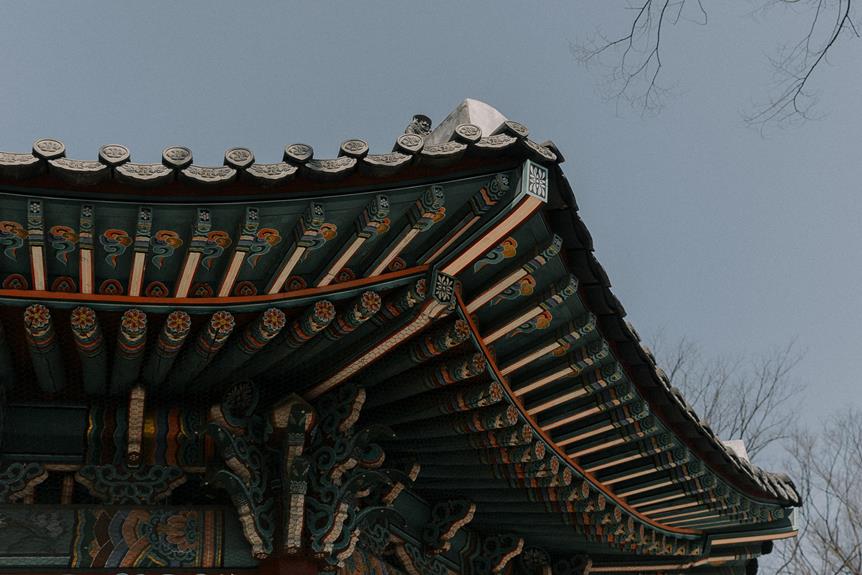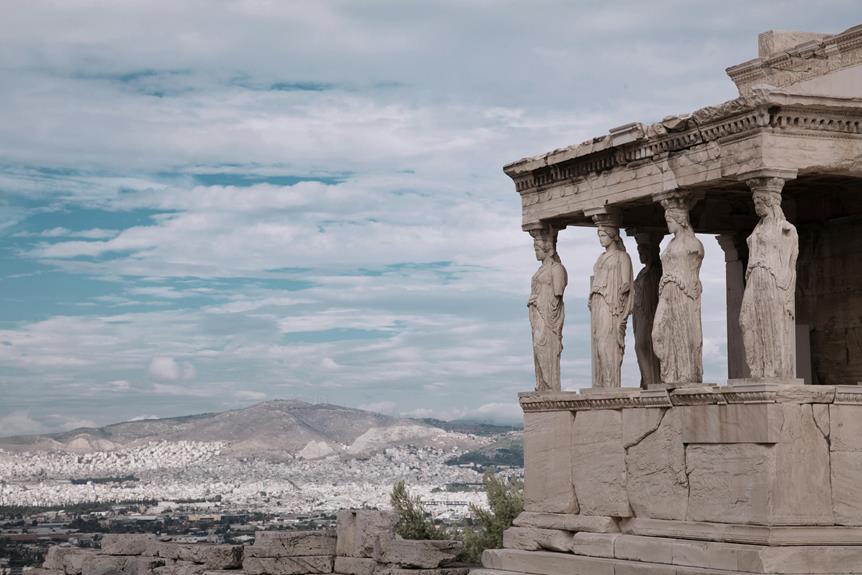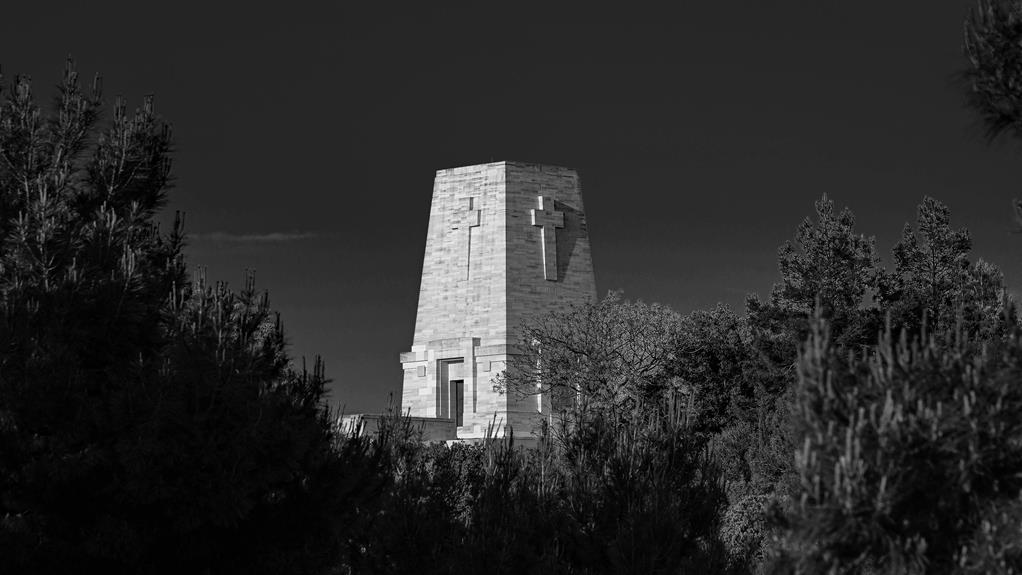Nestled in the heart of Hiroshima, Japan, stands a place that beckons visitors to contemplate the weight of history and the enduring quest for peace. Hiroshima Peace Memorial Park, with its solemn A-Bomb Dome looming as a stark reminder of the past, offers a glimpse into the tragedy that unfolded on that fateful day in 1945. But beyond its historical significance, this park holds stories of resilience, hope, and the unwavering pursuit of reconciliation. As visitors traverse its grounds, they are confronted with a profound narrative that transcends time and challenges us to reflect on the complexities of war and the human spirit.
Key Takeaways
- Established in 1955 to commemorate the atomic bombing.
- Houses the iconic A-Bomb Dome, a UNESCO World Heritage Site.
- Features memorials like the Children's Peace Monument.
- Includes peace museums focusing on nuclear disarmament.
- Encourages reflection on war's consequences and promotes peace.
History of Hiroshima Peace Memorial Park
Established in 1955, the History of Hiroshima Peace Memorial Park traces back to the devastating atomic bombing on August 6, 1945. The origins of the park lie in the desire to commemorate the lives lost during the bombing and to promote peace and understanding. The location was chosen strategically, near the hypocenter of the explosion, as a powerful symbol of resilience and remembrance.
The construction techniques employed in building the park were carefully selected to honor the history and significance of the site. The A-Bomb Dome, also known as the Hiroshima Peace Memorial, stands as a poignant reminder of the destructive power of nuclear weapons. The dome's skeletal structure, preserved in its ruined state, serves as a testimony to the horrors of war and the enduring hope for peace.
Throughout the park, various monuments and memorials have been erected to honor the victims and survivors of the atomic bombing. The Cenotaph for the A-Bomb Victims, with its arching shape symbolizing shelter for the souls of the deceased, is a central feature of the park. Visitors can also explore the Peace Memorial Museum, which provides a detailed look at the events leading up to the bombing and its devastating aftermath.
Significance of A-Bomb Dome
The A-Bomb Dome, standing as a poignant evidence to the catastrophic impact of nuclear warfare, holds profound significance within the narrative of Hiroshima Peace Memorial Park. This iconic structure, also known as the Hiroshima Peace Memorial, is the skeletal remains of the former Hiroshima Industrial Promotion Hall, which was one of the few buildings near the hypocenter to withstand the atomic bomb explosion on August 6, 1945. The dome serves as a powerful reminder of the devastation caused by the atomic bomb, symbolizing both the horrors of war and the resilience of the human spirit in the face of adversity.
The preservation efforts surrounding the A-Bomb Dome are a pledge to never forget the tragedy that befell Hiroshima. The site was designated as a UNESCO World Heritage Site in 1996, recognizing its importance as a historical witness to the dawn of the nuclear age and a call for peace. The architectural significance of the A-Bomb Dome lies in its unique blend of the past and present, where the exposed framework stands as a poignant symbol of remembrance and a stark contrast to the surrounding modern cityscape. It stands as a solemn tribute to the lives lost, urging visitors to reflect on the consequences of nuclear warfare and the importance of working towards a peaceful world.
Memorials Honoring Atomic Bomb Victims
Honoring the victims of the atomic bomb, the memorials within Hiroshima Peace Memorial Park embody a solemn tribute to those who lost their lives in the tragic events of August 6, 1945.
- Cenotaph for the A-Bomb Victims: A curved concrete monument sheltering the names of all the people who died due to the bombing, symbolizing a sanctuary for their souls.
- Children's Peace Monument: Dedicated to Sadako Sasaki and other child victims of the bomb, with thousands of origami cranes symbolizing peace and healing.
- Hiroshima National Peace Memorial Hall for the Atomic Bomb Victims: A space for visitors to learn about the personal stories of victims, including photos and belongings left behind.
- Flame of Peace: A flame that will continue to burn until the world is free from the threat of nuclear destruction.
- Memorial Ceremonies: Regular ceremonies are held to honor the victims, promote peace, and uphold that the memory of the events remains alive for future generations.
The memorials not only pay homage to those who perished but also serve as a striking reminder of the devastating effects of nuclear warfare.
Atomic bomb survivors, known as Hibakusha, often participate in these memorial ceremonies, sharing their stories to advocate for peace and nuclear disarmament. The memorials stand as a confirmation of the resilience of the human spirit and a call for a world without nuclear weapons, preserving that the legacy of Hiroshima's tragedy is never forgotten.
Peace Museums and Exhibitions
Located within Hiroshima Peace Memorial Park, the Peace Museums and Exhibitions offer a profound and insightful exploration into the impact of nuclear warfare and the pursuit of lasting peace. The museums provide a detailed look at the events surrounding the atomic bombing of Hiroshima, detailing the devastation caused and the subsequent efforts towards nuclear disarmament and peace-building.
The Peace Museums feature a variety of interactive exhibits that engage visitors in a multi-sensory learning experience. From personal accounts and artifacts from the bombing to thought-provoking displays on the long-term effects of nuclear weapons, visitors are encouraged to reflect on the consequences of war and the importance of working towards peace.
In addition to the exhibitions, the Peace Museums offer educational programs aimed at fostering a deeper understanding of the atomic bomb's impact on Hiroshima and the world. These programs include guided tours, lectures, and workshops that explore the historical, political, and humanitarian aspects of nuclear warfare.
Children's Peace Monument
Nurturing a profound symbol of hope and remembrance, the Children's Peace Monument stands as a poignant tribute to the innocent lives lost during the atomic bombing of Hiroshima.
- Origami Cranes: Thousands of origami cranes adorn the monument, symbolizing peace, healing, and resilience.
- Sadako Sasaki: The story of Sadako, a young girl who folded over a thousand paper cranes before her death, is deeply intertwined with the monument's significance.
- Children's Drawings: Surrounding the monument are heartfelt drawings by children from around the world, expressing messages of peace and unity.
- Innocence Lost: The monument serves as a powerful reminder of the devastating impact war has on the most vulnerable members of society.
- Educational Significance: Visitors can learn about the history of the monument and its connection to the broader themes of peace and reconciliation.
The Children's Peace Monument encapsulates the enduring spirit of hope and resilience in the face of tragedy. It stands as a beacon of light, urging future generations to work towards a world free from the horrors of war.
The combination of origami cranes, children's drawings, and the poignant story of Sadako Sasaki create a deeply moving experience that resonates with all who visit this profound symbol of peace.
Cenotaph for A-Bomb Victims
The Cenotaph for A-Bomb Victims at Hiroshima Peace Memorial Park stands as a solemn tribute to those who lost their lives in the atomic bombing. This monument, designed by architect Kenzo Tange, embodies profound memorial symbolism, inviting visitors to reflect on the devastating impact of war and the importance of peace. The Cenotaph's arched structure represents a shelter for the souls of the victims, offering a place for remembrance ceremonies and quiet contemplation.
Artistic tributes within the Cenotaph include the epitaph, which reads, 'Let all the souls here rest in peace, for we shall not repeat the evil.' These words echo the collective desire for a world free from nuclear warfare and serve as a poignant reminder of the horrors experienced during the bombing. The monument's inscription also emphasizes the importance of learning from the past to create a more peaceful future.
Survivor stories often resonate within the walls of the Cenotaph, as visitors pay their respects to those who suffered and perished. The monument stands as a beacon of hope, urging humanity to work towards a world where such tragic events are never repeated. Through its somber beauty and powerful message, the Cenotaph for A-Bomb Victims continues to touch the hearts of all who visit Hiroshima Peace Memorial Park.
Flame of Peace and Peace Bell
Symbolizing unity and remembrance, the Flame of Peace and Peace Bell at Hiroshima Peace Memorial Park serve as poignant reminders of the need for global harmony and reconciliation. The Flame of Peace burns continuously, representing hope for a world free from nuclear weapons and the horrors of war. The Peace Bell, designed with a map of the world without borders, invites visitors to ring it, sending wishes for peace to resonate across the globe.
- The Flame of Peace, lit in 1964, is a symbol of eternal peace and a call to end nuclear weapons.
- The design of the Peace Bell encourages visitors to contemplate peace and the interconnectedness of all nations.
- Visitors often take a moment of peaceful reflection, honoring the memories of those lost in the atomic bombing.
- The ringing of the Peace Bell creates a solemn yet powerful sound that echoes throughout the park.
- These symbolic gestures aim to inspire visitors to work towards a more peaceful and united world.
Both the Flame of Peace and the Peace Bell are not only significant symbols within the park but also serve as reminders of the devastating consequences of war. Visitors are encouraged to engage in peaceful contemplation and reflection, fostering a sense of unity and understanding among all who visit the Hiroshima Peace Memorial Park.
Hiroshima National Peace Memorial Hall
Located within the Hiroshima Peace Memorial Park, the Hiroshima National Peace Memorial Hall stands as an important tribute to the victims of the atomic bombing and a space for reflection on the enduring impacts of war. The memorial architecture of the hall is designed to convey a sense of peace and contemplation. Its sleek lines and minimalist aesthetic create a serene atmosphere that encourages visitors to pay their respects to the victims and ponder the devastating consequences of nuclear warfare.
Beyond its architectural significance, the Hiroshima National Peace Memorial Hall plays a significant role in educating visitors about the events of August 6, 1945, and the importance of peace. The hall offers various educational programs, including exhibitions, lectures, and survivor testimonies, aimed at deepening understanding and fostering a commitment to peace and reconciliation. Through these initiatives, visitors are able to engage with the history of the atomic bombing and its aftermath in a meaningful way, gaining insight into the human cost of war and the importance of working towards a peaceful future.
In essence, the Hiroshima National Peace Memorial Hall serves as an important reminder of the horrors of nuclear warfare while also offering a space for reflection, learning, and hope. It stands as a confirmation of the resilience of the human spirit and the enduring pursuit of peace in a world scarred by conflict.
Messages of Hope and Peace
In the aftermath of tragedy, the messages of hope and peace embedded within Hiroshima Peace Memorial Park resonate as beacons of resilience and humanity. This park stands as a testament to the enduring spirit of the people affected by the atomic bombing, offering visitors a profound experience infused with hopeful messages and peace symbols.
- Origami Cranes: Thousands of origami cranes, a symbol of peace and healing, can be seen throughout the park, left by visitors as a gesture of hope.
- Peace Bell: The Peace Bell, an iconic symbol of unity and harmony, invites individuals to ring it, spreading its message of peace across the park.
- Children's Peace Monument: Dedicated to the young victims of the bombing, this monument serves as a poignant reminder of the importance of peace and a hopeful future.
- Flame of Peace: The Flame of Peace, which will continue to burn until all nuclear weapons are eliminated, symbolizes the everlasting desire for a world free from nuclear threats.
- Memorial Cenotaph: The Memorial Cenotaph, containing the names of all those who perished, encourages reflection on the past while looking towards a future filled with peace and understanding.
Each of these elements within Hiroshima Peace Memorial Park encapsulates the essence of hopeful messages and serves as powerful peace symbols, inviting visitors to contemplate the significance of peace in a world scarred by conflict.
Frequently Asked Questions
How Can Visitors Support Ongoing Peace Efforts at the Park?
Visitors can actively support ongoing peace initiatives at the park through various means. Engaging in fundraising efforts, participating in volunteer opportunities, and contributing to community outreach programs are effective ways to show support.
Are There Any Specific Events or Ceremonies Held at the Park?
Annual commemorations and special ceremonies play a significant role in fostering peace initiatives and community events around the world. These events serve as platforms for remembrance, education, and advocacy for global peace. They provide opportunities for individuals and communities to come together, reflect on past tragedies, and work towards a more peaceful future.
Such ceremonies often include speeches, performances, exhibitions, and other activities that promote unity and understanding among diverse groups.
Can Visitors Leave Offerings or Tributes at the Memorials?
Visitor customs at memorials often involve leaving offerings or tributes to honor the memory of those commemorated. This act of remembrance is a significant part of memorial etiquette, symbolizing respect and reverence for the lives lost or events remembered.
Whether through flowers, candles, notes, or other tokens, visitors often find solace in leaving behind personal tributes as a way to connect with the past and pay their respects.
Are There Any Educational Programs Available for Visitors?
Visitors can enrich their experience through educational programs at various sites globally. Cultural workshops provide hands-on learning opportunities, while interactive exhibits engage audiences of all ages. Historical tours offer insights into the past, shedding light on significant events. Language classes cater to those seeking to deepen their understanding through linguistic immersion.
These programs add depth and context to visitors' exploration, enhancing their overall appreciation and knowledge of the site they are visiting.
What Are the Park's Sustainability and Eco-Friendly Initiatives?
Sustainable practices and environmental initiatives play a pivotal role in the operational framework of many modern parks. These strategies aim to reduce the ecological footprint, promote conservation efforts, and foster a harmonious relationship with nature.
Implementing sustainable practices like energy-efficient lighting, waste reduction programs, and green landscaping not only benefit the environment but also contribute to the overall well-being of the community. These initiatives showcase a commitment to responsible stewardship and long-term environmental sustainability.
Conclusion
To sum up, the Hiroshima Peace Memorial Park in Japan stands as a somber reminder of the tragic events that unfolded on August 6, 1945. Through its memorials, museums, and monuments, the park serves as a powerful symbol of the devastating impact of nuclear warfare and the ongoing pursuit of peace and reconciliation.
It is a place where visitors can reflect on the past and contemplate a future free from such devastation.


